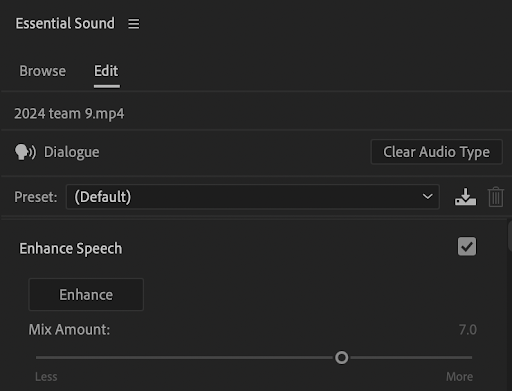7 Ideas for High School Video Projects
If you are running a video production classroom, you are probably going to give your students the chance to get out and make a video. At least I hope you do. They will want to actually use the equipment and you, well, you will enjoy a few minutes of silence as your class empties with student production teams tearing off down the halls in a creative fervor.
[The next time that happens, take out your camera and do a panning selfie with your empty room behind you. In the Georgia Broadcast Video Teachers Facebook group, we call that a Buechner, in honor of Chris Buechner, the rockstar teacher at Centennial High School in Alpharetta, Georgia. Quick plug… the Facebook group is open to teachers from all over the globe, so don’t think you have to be from Georgia to find your online community. The group is seriously the best professional development that you will get in our niche.]
Now you just need a few projects for them to work on. Here are a few ideas:
Short Films
Creating short films is an excellent way for students to showcase their storytelling skills and creativity, while also learning how to use filmmaking tools to visually convey their message. When I'm running a video production classroom, I usually encourage students to work in groups to create a narrative story that is no longer than five minutes in length. While they may beg for more time, I find that the sweet spot is often around three minutes.
The key to a successful film project is to help students understand how shots convey meaning and encourage them to think through the message of their shots. I always start by having them brainstorm ideas, write a script, and create a storyboard to map out the scenes and shots they plan to include.
Once they have a solid concept, students can move into the pre-production stage, where they will secure locations, cast actors, and assemble any necessary props or costumes. Then comes the filming stage, where they will work together to capture all the shots and scenes they need to tell their story, using cameras, lighting adjustments, and directing actors to deliver their lines or actions.
Finally, students will enter the post-production phase, where they will edit the footage they have captured into a final film, cutting together different takes of the same scene, adding special effects or music, and fine-tuning the color and sound to produce a polished product.
Overall, creating short films is a challenging yet rewarding project that helps students develop their creativity, teamwork skills, and technical filmmaking abilities.
A music video is a great way to engage with students where they are.
Music Videos
If you're running a video production class, you might want to consider having your students create a music video for a song of their choice. This project can help students learn how to use visual storytelling techniques to complement music and tell a story.
Since a music video is a short film that accompanies a piece of music, the best music videos are those that tell a compelling story while incorporating performance aspects. For instance, I once had my students create a Christmas music video project where they combined a performance element with a narrative element. It was exciting to see them bring these two things together in their projects.
To start this project, your students can work in groups and select a song that they feel passionate about. They can then create a music video that reflects the mood, theme, or message of the song. They can experiment with a range of techniques, such as choreography, lighting effects, animation, or performance footage, to visually convey the meaning of the music.
Once they have a solid concept, students can begin the pre-production process, which involves securing locations, casting actors or performers, and gathering any necessary props or costumes.
Next, students can move into the filming stage, where they'll need to work together to capture all of the shots and scenes they need to tell their story. This can involve setting up camera angles, adjusting lighting, and directing performers to deliver their best performances.
Finally, students can move into the post-production phase, where they'll edit the footage they've captured into a final music video. This can involve cutting together different takes of the same scene, adding special effects or animation, and fine-tuning the color and sound of the final product.
Public Service Announcement (PSA)
If you're looking for an engaging and impactful project for your students, why not have them create their own public service announcement (PSA)? PSAs are short videos or audio messages that are designed to raise awareness about important issues and inspire viewers to take action.
Whether your students are passionate about environmental issues, social justice, or health and safety, they can use a PSA to get their message out there. Through the use of interviews, statistics, visual storytelling, and music, they can craft a powerful message that will resonate with their audience.
To get started, students should choose a topic and develop a clear message for their PSA. They can conduct research, gather information and statistics, and create a script or storyboard. I have found that there are a lot of PSA opportunities from outside sources which might even offer prizes to benefit and encourage your students.
Once they have a solid concept in place, students can move on to the pre-production stage, which involves securing locations, casting actors or participants, and gathering any necessary props or materials.
Then comes the fun part – filming! Students will need to work together to capture all of the footage they need to create their PSA. This can involve conducting interviews, capturing b-roll footage, and recording voiceovers.
Finally, students will move into the post-production phase, where they can edit their footage into a final PSA. This involves cutting together different takes, adding special effects or music, and making sure the final product looks and sounds great.
Overall, I think that creating a public service announcement is a fantastic way for students to develop their research, communication, and technical filmmaking skills. Plus, it's a great opportunity for them to use their creativity to make a positive impact on the world!
This might be a good time to introduce your students to the possibility of using AI in production. I recently spent a good portion of a class going over ChatGPT with my students, and how it could serve as a starting point in a local PSA competition. I recently posted an article on Embracing AI in the Video Classroom if you’d like to check it out.
Stories matter; stories about people matter more.
Documentary
If you're looking for a great project to challenge your students and help them develop their research, communication, and technical filmmaking skills, then a documentary might be just what you need. This type of non-fiction film explores a particular subject or topic in-depth, often through interviews, archival footage, and narration.
Your students can work individually or in groups to create a short documentary on a topic that they're passionate about. They can use a variety of techniques, such as conducting interviews, gathering archival footage, and using animation or visual storytelling, to explore their subject and make it come alive on screen. A documentary is a little different from a creative video because the pre-production and production phases are somewhat overlapped. You need interviews before you write and you need to know what the subject is talking about before you get the b-roll. Whatever the case, capturing compelling images will help to bring the story to life.
In the post-production phase, your students will edit their footage into a final documentary. This can involve cutting together different interviews and footage, adding music or voiceovers, and fine-tuning the color and sound of the final product.
A documentary can be a challenging but rewarding project that will help your students develop a range of skills and tell a compelling and informative story. The skills of documentary production also closely align with longform podcast stories as well, so maybe your students could skip the visuals all together and create a world of sound.
There are no rules in experimental film. (There are still school rules though!)
Experimental Film
When it comes to film projects, creating an experimental film can be an interesting way for students to push creative boundaries and explore new possibilities. This type of project involves experimenting with various techniques and styles to create an abstract or non-narrative film that delves into themes such as emotion, identity, or perception.
Through this project, students can develop their skills in visual storytelling, sound design, and communication. To get started, they should identify a theme they want to explore and then brainstorm ideas individually or in groups. Once they have a solid concept, they can begin experimenting with different techniques such as slow motion, time-lapse, and abstract imagery to capture footage and audio that visually represents their chosen theme.
In the post-production phase, students will need to edit the footage and audio they have captured into a final experimental film, which can involve cutting together different shots, adding sound effects or music, and fine-tuning the color and sound of the final product. The process can be challenging, but also highly rewarding, as students get to explore their creativity and artistic vision while also developing important technical filmmaking skills.
Adaptation
As a video production teacher, you probably encourage your students to take the opportunity to create their own videos. But have you considered encouraging them to adapt a short story, poem, or play into a film? This project not only challenges students to think critically, but also develops their skills in storytelling, character development, visual and audio design, and critical analysis.
To start, students can select their own piece to adapt and brainstorm ideas to translate it into a film. While individual tasks work best, a group effort can help to refine and enhance their concepts.
Once they have a solid concept, students can break down the original work into individual scenes and identify key elements that need to be captured in their film. They can then create a storyboard or script outlining how each scene will be shot and edited. After this… they film.
When the filming stage is complete, students move on to post-production. During this phase, they have the opportunity to showcase their skills in technical filmmaking and communication. They can cut together different takes, add music and sound effects, and fine-tune the color and sound to create a polished final product.
Adapting a short story, poem, or play into a film is a rewarding project that allows students to think creatively and critically. By exploring the challenges of translating one medium into another, they gain a deeper appreciation for the power of storytelling.
Mockumentary
I love a good mockumentary. Personally, I think a mockumentary is one of the most intelligent forms of comedy, but I am sure some of you might disagree. That being said, satirizing a particular subject can lead to very funny content. The downside? Too many people are offended by comedy these days, so you’ll need to proceed with caution.
To begin this project, students will need to decide on a subject that they want to satirize. They can work individually or in groups to brainstorm ideas and develop a plan for how to tell their fictional story in a documentary style. It can be easy to land on stereotypes when developing a mockumentary, so be careful how that is handled.
Once they have a solid concept, students can begin the production process, which involves filming the mockumentary. They can use handheld cameras or stationary setups to capture the footage, just like in a real documentary. They can also incorporate interviews with fictional characters or people who are in on the joke to add to the satirical nature of the film.
After filming, students will transition to the post-production phase, where they will edit the footage to create a final mockumentary. To enhance the comedic effect, they can add sound effects, music, and voiceovers. They can also experiment with editing techniques such as jump cuts, slow motion, or time-lapse to add an extra layer of humor.
Overall, creating a mockumentary is a fun and creative project that allows students to develop their skills in storytelling, communication, and technical filmmaking. By using humor and satire to explore a subject, students can convey their message in an engaging and entertaining way while developing valuable skills that can be applied to future projects.
Conclusion
In the end, there are tons of cool video projects for high school students to explore and grow their storytelling, technical, and creative skills. They can make anything from a short film to a music video or mockumentary, using various mediums to express their message and ideas. Plus, by working in groups, students can learn communication and collaboration skills that'll come in handy in the future. And let's not forget that video production is an awesome way for teachers to get their students to think critically, creatively, and analytically about media.
By using the ideas discussed in this essay, high school video production teachers can inspire their students to create incredible videos that showcase their unique perspectives and skills. With different genres to choose from like drama, music, documentary, and comedy, there's a project for everyone. Video production projects can also be a fantastic way for teachers to connect with their students and encourage their love for filmmaking. All in all, video production projects can provide a meaningful and fulfilling experience for students, equipping them with skills that they can use for the rest of their lives.
Now, give those kids a camera and set them off creating. And be sure to share your “Buechners” with us on social media. Use #BuechnerCentennial to let everyone see why being a video teacher is the best job you can have.
Meet the Author, JOSH DEMPSEY
Josh Dempsey is a video and film teacher at Marietta High School in Marietta, Georgia. With over 15 years of experience in the classroom, Josh is just as excited as his students to keep learning about the power and possibilities of this visual medium. He invites you to follow his students and their work online by following them on social media @bdn_marietta.












As summer winds down, the familiar rhythm of a new school year approaches. For educators like James Peach, the weeks leading up to students' return aren't just about shuffling papers; they're a strategic dance of preparation, aiming to ignite inspiration and cultivate self-sufficiency.